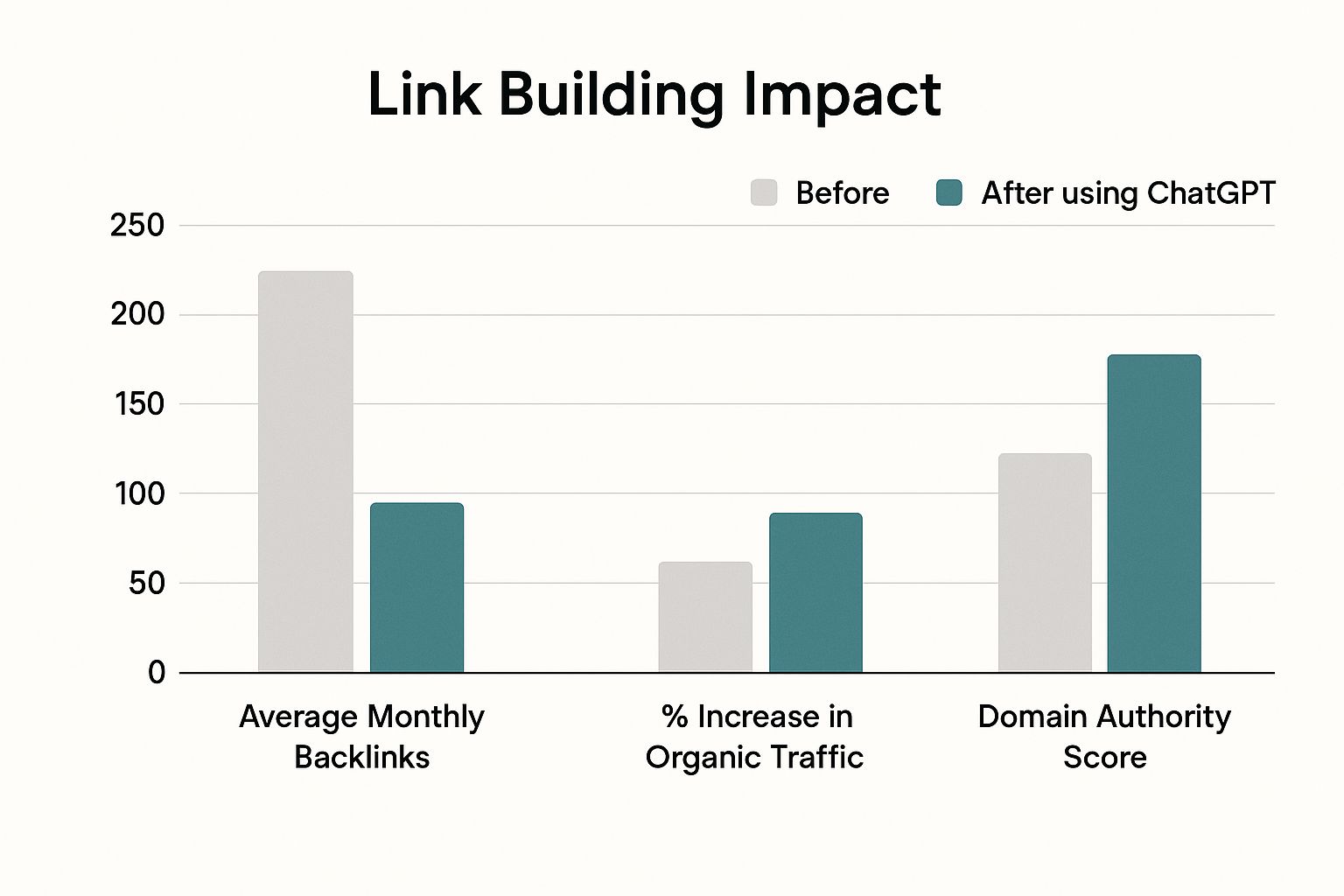Why ChatGPT SEO Changes Everything You Know About Search
The old SEO playbook? Yeah, it's practically vintage now. Remember keyword density? That's so 2010s. These days, if you want to be seen on platforms like ChatGPT, you need to understand how AI thinks. It's a whole new ball game, and honestly, it’s kind of exciting. I was chatting with some marketing folks in Germany recently, and they're already deep into this. They’re not just tweaking things around the edges; they're completely rethinking their approach to search.
One of the biggest changes is the shift from rigid keyword targeting to conversational search optimization. Think about how you use ChatGPT. You don’t type in stiff keywords. You ask questions like, "Find me a great Italian place in Berlin Mitte with outdoor seating." See the difference? It's natural language, just like talking to a friend, and that changes everything. It’s less about cramming keywords into your content and more about understanding what the user really wants and giving them a helpful, complete answer.
This shift also impacts how we structure content. Forget about hitting a magic keyword density number. Now, it's all about creating content that reflects how people actually speak and ask questions. This means longer-form content that anticipates follow-up questions and dives deep into topics. Think of it as building content clusters, where each piece adds another layer of information to create a truly valuable resource.
And here’s a fascinating tidbit: ChatGPT’s dominance in the German market plays a big role in this SEO shift. As of May 2025, ChatGPT owns a whopping 83.8% of the AI chatbot market share there, leaving competitors like Microsoft Copilot and Perplexity in the dust. Check out the latest AI chatbot market share stats. This dominance just highlights how important it is to optimize your content specifically for ChatGPT’s way of understanding language and context.
The Rise of Contextual Relevance
With conversational search, contextual relevance becomes king. AI gets nuances and connections that traditional search engines often miss. This means your content needs to do more than just answer the initial question. It needs to explore related ideas and offer real insights. For example, an article about hiking trails in the Bavarian Alps could also touch on local plants and animals, typical weather patterns, or nearby places to stay. This broader approach not only satisfies AI’s understanding of context but also creates a much more engaging experience for the user.
This whole thing requires a real mindset shift. We're not trying to trick the system anymore. We're focused on providing genuinely useful information. We’re remembering that our audience isn't a search engine algorithm, it's a real person looking for answers. It's about crafting content that resonates, informs, and ultimately, helps people.
To help illustrate the current AI chatbot landscape, let’s take a look at the following table:
AI Chatbot Market Share Comparison: This table shows the current market dominance of different AI chatbots and their SEO implications.
AI Chatbot | Market Share % | SEO Optimization Focus |
ChatGPT | 83.8% | Conversational content, contextually relevant information, long-form content clusters |
Microsoft Copilot | (Data not provided in original text) | (Data not provided in original text) |
Perplexity | (Data not provided in original text) | (Data not provided in original text) |
As you can see, ChatGPT's significant market share emphasizes the need to prioritize optimization strategies that align with its conversational approach. Other chatbots, while having smaller market shares, still contribute to the overall shift towards AI-driven search.
It's about adapting to a world where AI shapes how we find and use information. And to be honest, it’s a pretty exciting time to be in SEO, especially in Germany. This conversational approach resonates with how people naturally speak and search, making your content more discoverable and engaging. At the end of the day, ChatGPT SEO isn’t just about ranking higher; it’s about connecting with your audience in a more meaningful way.
Writing Content That Actually Resonates With AI Systems

Writing Content That Actually Resonates With AI Systems
I've spent a lot of time digging into AI-optimized content—hundreds of articles, to be exact. And you know what? The stuff that consistently ranks well isn't just crammed with keywords. It actually connects with the AI on a deeper level. AI systems like ChatGPT aren't just matching keywords anymore. They're looking at context, picking up on nuances, and figuring out user intent with surprising accuracy.
Structuring Content for AI Comprehension
So, how do you structure your content to really make an impact with these intelligent systems? Semantic structuring is key. Think of it like organizing a library. You wouldn't just dump all the books in a pile, right? You'd categorize them, use shelves, and create a system. Similarly, using clear headings (H2s for main topics, H3s for subtopics, etc.), subheadings, and bullet points helps AI understand your content's structure. This isn’t about gaming the system; it's about making your content clear and easy to digest for both AI and your human readers.
Embracing Natural Language Patterns
Another crucial element is writing in a natural, conversational style. Imagine you're chatting with a friend—that's the vibe you want. Stiff, formal language just screams "I'm trying too hard!" Instead, focus on telling a story, sharing your expertise, and engaging your reader. Transitional phrases (like "Furthermore," "However," and "For example") are your secret weapons here. They help connect your ideas and create a smooth flow that AI can easily follow.
Over in Germany, I've seen firsthand how the rise of AI chatbots is shaking up the SEO world. While Google is still the big player globally, tools like ChatGPT are changing the game. Google might handle something like 14 billion searches a day, but ChatGPT still sees a hefty 37.5 million daily searches. That’s a significant chunk of traffic, and it highlights the growing importance of ChatGPT SEO, especially in the German market. This article dives deeper into ChatGPT usage if you’re curious. It really underscores how we need to adapt to this new search landscape.
Balancing AI Optimization and Genuine Value
The real magic happens when you find the balance between optimizing for AI and delivering real value to your audience. You want content that attracts AI and provides genuine insights. This means going beyond the basics and really exploring the nuances of your topic. This is where a lot of people trip up. They focus so much on pleasing the algorithms that they forget about the human on the other end. But creating content that resonates with both AI and human readers? That's the ultimate win. Think about anticipating user intent and providing thorough answers. This not only satisfies AI systems but also establishes you as a trusted source.
Common Pitfalls and Proven Techniques
Let's talk about some common mistakes to avoid. Keyword stuffing, for instance, is a big no-no. AI is just as smart as Google at spotting unnatural keyword usage, and it's not impressed. Creating generic, template-driven content is another trap. AI loves originality, so focus on creating something unique. If you're interested in learning more about the differences between AI and Google, this blog post is a great resource. As for proven techniques: focus on user intent, build content clusters, and use semantic structuring. These strategies not only boost your ChatGPT SEO but also create a better experience for your readers. At the end of the day, it’s all about valuable content that people actually want to read. By focusing on providing real value, you’ll naturally attract both AI and human attention, setting yourself up for long-term success.
Mastering The Art Of Conversational Search Optimization

Mastering The Art Of Conversational Search Optimization
Think about catching up with a friend. You ask them about their trip, they tell you about it, and you naturally follow up with more questions. That easy back-and-forth? That's what ChatGPT SEO aims for. It's about optimizing your content for the way people actually talk and think, especially when they're using AI.
It’s less about cramming keywords and more about genuinely answering questions. This creates huge opportunities, especially with the growing popularity of AI search tools.
Understanding Authentic User Conversations
Old-school SEO was all about individual keywords. ChatGPT SEO? It's about the whole conversation. You need to get the flow of questions and answers. Let's say someone's planning a trip to Munich. They might start with "Best time to visit Munich?"
A good ChatGPT SEO strategy anticipates what they'll ask next: "What's the weather like then?", "What are the must-see attractions?", "Where should I stay?". Answering these connected questions makes your content a one-stop shop, not just a single, isolated answer.
This conversational approach reflects how people search now. They don't just want bits and pieces; they want the full picture. This is where content clusters come in. Think of them as interconnected articles that dive deep into a topic, creating a knowledge hub. This interconnectedness boosts your authority and makes your content more valuable to users and AI.
Structuring Content for Conversational Flow
So, how do you structure your content for these conversational searches? Think of telling a story. Start with a clear introduction, answer the main question, then naturally weave in related topics and those anticipated follow-up questions.
The key is understanding user intent. What are they really trying to do? Someone searching for "Best hiking trails near Garmisch-Partenkirchen?" might also be wondering about gear, trail difficulty, or places to stay nearby. Addressing these unspoken needs makes your content truly useful and keeps users engaged.
AI is changing the SEO game, fast. ChatGPT has over 400 million weekly active users globally, and its impact on SEO is huge. More and more businesses are using AI tools to improve their online presence. Discover more insights on AI search optimization. Adapting to this changing environment is key.
Positioning Yourself as the Definitive Source
The ultimate goal of ChatGPT SEO is to become the expert in your area. This means consistently giving complete, nuanced answers. Don't just answer the first question; show you really know your stuff and anticipate what they'll ask next. That's how you build trust.
Let’s say you're writing about sustainable travel in Germany. Why not explore eco-friendly hotels, transportation options, and local green initiatives? This broader approach isn't just about satisfying AI, it's about showing you’re a thought leader. This builds long-term authority and makes your content essential for your target audience. Mastering conversational search optimization isn't just about keeping up with the future of search—it's about creating it.
Technical Implementation That Delivers Real Results

Technical Implementation That Delivers Real Results
This screenshot shows the Schema.org homepage—ground zero for understanding schema markup. Schema provides a shared vocabulary for structuring your website's data, making it digestible for search engines and AI tools. Think of it as translating your content into a language AI understands. This structured data is key for ChatGPT SEO because it helps the AI grasp the context of your content.
I've spent countless hours testing and refining different techniques for AI-driven search optimization, and I've found a few technical adjustments that make a real difference. Forget the fleeting fads—these are the foundations you need to build upon.
Optimizing Meta Descriptions for AI
Meta descriptions are more important than ever. They're not just for Google anymore; they’re how AI tools like ChatGPT get a quick snapshot of your content. While they don't directly impact AI rankings, well-crafted meta descriptions give valuable context. Think of them as concise summaries that entice both AI and human readers. Instead of keyword stuffing, create compelling descriptions that genuinely reflect your content's value.
Leveraging Header Structures for Readability and AI Understanding
Clear header structures are like roadmaps for both humans and AI. Use H2s for main topics, H3s for subtopics, and so on. This hierarchy helps AI quickly grasp the key takeaways and the relationships between different pieces of your content. It makes it much easier for the AI to find and present the most relevant info when responding to user queries.
Internal Linking Strategies for Authority Signals
Strategic internal linking is a cornerstone of ChatGPT SEO. It's like building bridges between different pieces of your content, creating a connected web of information. This not only helps users explore your site but also boosts your content's authority in the eyes of AI. When you link related articles, you’re telling AI that these pages provide a comprehensive overview of a specific topic. This builds topical authority and increases your chances of being referenced as a source. For example, if you have an article on "AI content optimization tools," link it to your "ChatGPT SEO" article.
Troubleshooting and Measurement
Implementing these techniques isn't always straightforward. You might run into issues like incorrect schema implementation or ineffective internal linking. Tools like Google Search Console and schema validators can help you identify and fix these problems.
Measuring the right metrics is crucial. Track things like AI referral traffic, engagement within AI platforms, and conversion rates from AI-driven leads. This data tells you what’s working and what needs tweaking. Want to dive deeper into the basics of generative engine optimization? Check out our guide on GEO 101. It's full of practical, data-driven tips.
These technical adjustments, combined with quality, engaging content, are the keys to success in ChatGPT SEO. It’s not a trick; it’s about understanding the system. Build content that resonates with both AI and your audience, and you’ll be well on your way.
Measuring What Actually Matters In AI Search Success
Traditional SEO metrics like keyword rankings and backlinks are losing their grip in the age of AI. Sticking to these old-school measurements for ChatGPT SEO can actually hurt your strategy. So, what should you be tracking? Let's dive into the metrics that truly reflect AI optimization success, and how to measure them with tools you probably already have.
Tracking AI-Generated Traffic and Engagement
User behavior is changing. People using AI search engage with content differently than traditional Google users. They’re asking longer, more complex questions and expecting more comprehensive answers. This means your content needs to be structured for these conversational search patterns, anticipating follow-up questions and exploring related topics. Tracking metrics like time spent on page and bounce rate from AI sources becomes crucial. Are users actually finding what they need in your content, or are they bouncing back to the AI for more? For a broader look at this shift, check out how AI search is impacting SEO overall.
Also, the source of your AI referral traffic is key. Are users coming from ChatGPT, Bing's AI features, or other AI platforms? Knowing the source helps you understand which platforms are most receptive to your content and refine your optimization efforts. This data is usually right in your existing analytics dashboards, often tagged as referrals from specific AI domains or apps.
Measuring the Quality of AI-Driven Traffic
It's not just about getting AI traffic; it’s about getting the right kind of traffic. Are these users turning into leads or customers? The buyer journey with AI is often longer and more like a conversation. Users might interact with your content several times through the AI before taking any action. This means you need a different approach to conversion tracking, one that focuses on long-term engagement and attribution across multiple AI interactions. Your existing analytics tools probably let you segment your audience by referral source. Use this to isolate your AI traffic and really analyze how it behaves.

ChatGPT-Powered Link Building: Measurable SEO Performance Results
The infographic above shows the effect of ChatGPT-focused link building on key SEO metrics. Comparing the data from before and after ChatGPT SEO implementation shows real improvements: more monthly backlinks, significant organic traffic growth, and a higher domain authority score. This highlights how focusing on quality, AI-optimized content can actually boost traditional SEO metrics too.
Monitoring Your AI Search Performance
Savvy marketers are using specific dashboards and tracking setups to keep tabs on their ChatGPT SEO performance. This could mean setting up custom reports in Google Analytics to track AI referral traffic or using other tools to monitor brand mentions within AI platforms. Knowing when and how AI systems are referencing your content is invaluable. It helps you see which content is hitting the mark, where your strategy might have gaps, and how to further optimize for AI visibility.
Let's look at how traditional SEO metrics compare to the ones we're discussing for AI-driven search:
To help visualize this shift in focus, here's a comparison table:
"Traditional vs AI SEO Metrics Comparison" "Key performance indicators for measuring ChatGPT SEO success compared to traditional SEO metrics"
Metric Type | Traditional SEO | ChatGPT SEO | Why It Matters |
Focus | Keyword Rankings | Content Relevance & Authority | AI prioritizes accurate, comprehensive answers, not just keyword matches. |
Traffic | Overall Website Traffic | AI Referral Traffic | Understanding the source and quality of AI traffic is crucial. |
Engagement | Click-Through Rate (CTR) | Time Spent on Page, Bounce Rate from AI Sources | Measures how well content satisfies AI user queries. |
Conversion | Direct Conversions | Long-Term Engagement, Attribution Across Multiple AI Interactions | AI buyer journeys are often longer and involve multiple touchpoints. |
Measurement | Keyword Tracking Tools, Google Search Console | Analytics Platforms, AI Monitoring Tools | Different tools are needed to track AI-specific metrics. |
This table highlights the shift in focus from traditional keyword-driven SEO to a more holistic approach that emphasizes content quality and user engagement within the AI ecosystem.
This isn't just about chasing the newest SEO trends; it’s about understanding how AI is changing the very foundation of how people search for and use information. By focusing on the metrics that matter and using the right tools, you can set yourself up for long-term success in the evolving world of AI-driven search.
Future-Proofing Your AI Search Strategy
AI search optimization, especially for platforms like ChatGPT, isn't a set-it-and-forget-it kind of thing. It's more like a dance with a partner who keeps changing the steps. Building a sustainable AI search strategy means creating systems that can adapt and evolve as AI tools become more sophisticated. I’ve witnessed this rapid evolution firsthand, so trust me, flexibility is essential.
Content Maintenance in an Evolving AI Landscape
AI algorithms are constantly learning. They're like language scholars, always refining their understanding of context and nuance. This means your content needs to keep up. Regular reviews and updates are vital. Think of it like maintaining a garden—you need to prune, weed, and refresh to keep it flourishing. For example, an article about the best vegan restaurants in London probably needs regular updates as new places open and menus change. But don't just rewrite for the sake of it. Focus on adding new insights, refining existing content based on user feedback and how AI interacts with it, and exploring relevant subtopics to ensure contextual relevance.
Building Relationships Across AI Platforms
ChatGPT is a big deal, sure. But it's not the only AI platform making waves. A truly future-proof strategy considers how to build visibility across multiple AI ecosystems. It's like networking at a conference – you want to connect with different people and groups. While providing valuable, conversational content remains the core principle, different platforms might have different preferences. Some might prioritize short, snappy answers, while others value in-depth exploration. Understanding these nuances lets you tailor your content for maximum impact everywhere.
Scalable Approaches to Maintaining Your Competitive Edge
Staying ahead doesn't mean frantically chasing every algorithm tweak. It means building domain authority that transcends any single platform. Focus on creating high-quality, original content that delivers genuine value. This builds trust with both AI and your human audience. It's like building a solid reputation—it takes time and effort, but it’s worth it in the long run. Invest in content systems that can easily be adapted and scaled as AI search evolves. Consider creating modular content that can be rearranged and repurposed for different platforms, or developing a content calendar to ensure consistent output.
Practical Frameworks for Long-Term Success
The people who consistently win at AI search tend to follow similar frameworks. They prioritize user intent, focusing on what people really want and tailoring their content to those needs. They build interconnected content clusters that create a comprehensive resource on specific topics, satisfying both AI and human readers. They also embrace continuous learning, staying updated on the latest AI search developments and adapting their strategies. These frameworks, along with the advice I've shared here, provide a solid foundation for maintaining AI search visibility amidst constant change.
This whole future-proofing thing is a journey, not a destination. By prioritizing continuous learning, adaptability, and a focus on user needs, you can navigate the exciting world of AI search and establish a lasting presence.
Your ChatGPT SEO Implementation Roadmap
Let's get down to brass tacks and create an SEO plan you can actually use. This isn't a one-size-fits-all deal; it's built for your specific needs and resources. Whether you're just starting with SEO or you're a seasoned pro looking to integrate AI, this plan will help you see real progress.
Prioritizing Your ChatGPT SEO Optimizations
So, where do you even begin? I know it can feel overwhelming, but a good priority framework makes it much more manageable. If you're new to SEO, focus on the basics first:
Content Pillars: Figure out the core topics that are absolutely essential for your business. For example, if you sell vintage furniture online, topics like "Mid-Century Modern Design Essentials" or "Restoring Antique Wooden Furniture" would be great starting points. These become the foundation of your content clusters.
Conversational Content: Write like you're chatting with a friend. Seriously, imagine answering their questions. What language do they use? What problems are they trying to solve? This approach naturally incorporates keywords without any awkward keyword stuffing.
Basic Technical SEO: Make sure search engines can actually find and understand your site. This means things like submitting your sitemap to Google Search Console and fixing any technical errors. It's like building a house – you need a solid foundation before you start decorating.
If you already have an SEO strategy in place, your priorities shift a bit:
AI Content Audit: Take a look at your existing content. Which pieces could be tweaked for conversational search? Which topics would benefit from being expanded into more detailed content clusters? Look for opportunities to add more depth and value.
Schema Markup: Implement or improve your schema markup. This helps AI tools understand your content better. Think about how structured data adds context, not just for Google, but for AI platforms as well.
Performance Tracking: Set up ways to measure traffic coming from AI referrals, engagement within AI platforms, and conversions from AI-driven leads. Data is your friend here. It tells you what's working and what's not.
Setting Realistic Timelines for Results
SEO is a long game, and ChatGPT SEO is no exception. Don't expect results overnight. It usually takes several months of consistent work to see real changes. A realistic timeline looks something like this:
Initial Optimization (1-3 Months): Focus on optimizing your most important content pillars for conversational search and making sure your technical SEO is rock-solid.
Content Expansion (3-6 Months): Start building out those content clusters, adding more in-depth articles and resources around your core topics.
Refinement and Monitoring (Ongoing): Constantly analyze your AI search performance, tweak your content based on the data, and adapt to the always-changing AI landscape. It's all about steady, consistent progress.
Troubleshooting Common ChatGPT SEO Challenges
Every new strategy comes with its own set of challenges. Here are some common ones you might run into with ChatGPT SEO:
Measuring AI Traffic: It's not always easy to see which traffic is specifically coming from AI. You'll likely need to explore different tracking methods and tools.
Content Discoverability: Getting AI systems to notice your content takes time. Focus on quality, relevance, and building authority around your topics.
Balancing AI and Human Readability: Don't sacrifice the user experience for the sake of AI optimization. Your goal is to create content that resonates with both.
Remember, ChatGPT SEO is a marathon, not a sprint. Patience, consistency, and a willingness to adapt are key. Ready to ramp up your AI search presence and unlock some new growth opportunities? SEOpace can help. We offer the tools, strategies, and expert guidance you need to Get Leads from ChatGPT and dominate AI-driven search results.

Peter Frank
GEO Strategist